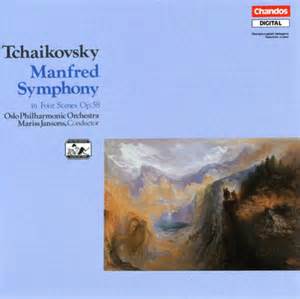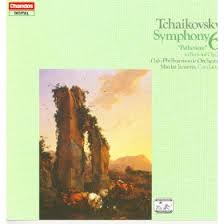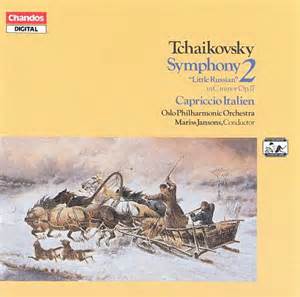A personal reassessment of the Oslo Philharmonic’s Chandos recordings – 1984 -1989

Tchaikovsky: Symphony in B minor, Op. 58 , “Manfred”
On August of 1986, Mariss Jansons and the Oslo Philharmonic played the Sixth Symphony of Tchaikovsky in concerts and on a quick tour to Edinburgh. Upon returning to Oslo, the orchestra recorded it for Chandos. These were full sessions, and every expectation was that this would be released in the fall. However, that didn’t happen. For some reason – mainly dealing with conductor’s instinct – the tapes were set aside and new sessions were scheduled for November of 1986. In the meantime, the orchestra and Jansons went ahead with the previously scheduled recording sessions for “Manfred”,which would follow a pair of subscription concerts. In addition, the concerts were recorded for TV broadcast by the NRK, and the orchestra did the recording sessions around the concerts and on the weekend after. James Burnett was again our producer, as the Couzens father and son team were involved in another project.
The symphony was not in the orchestra’s regular repertoire, but Jansons managed to get it in tip-top shape for both concerts and recordings.
The symphony is not among Tchaikovsky’s numbered symphonies, and is listed as Opus 58. It is based” on scenes from the life of “Manfred”, a Byronic character and it is difficult to bring off well in concert, much less in recording. It calls for a large orchestra and includes an organ in the final movement. Concerts and recording sessions went well enough. For my own part, I was “playing in” the Light Met B’s and our newly purchased 31 inch Continental chain drum, with the 25 inch Hinger timpano as top drum -I didn’t want a smaller drum for the E’s in the finale.
It was with bated breath that I eagerly awaited the release of this recording, and when it finally came out, and I received my personal copy, I was both pleased and a little disappointed at the same time. The sound was good enough, although it was little light in the bass- especially the bass drum. Everything else was good – mid-range and highs just fine, but the bass lacked the punch I was expecting. The orchestra played the heck out of this piece in both the concerts and recording – but I felt that somehow, the recording let us down. The acoustics of the venue always let us down in terms of bass response, and despite all of James Burnett’s magic, the bogeyman of the acoustic got the better of all of us in terms of bass-response.
Thirty-odd years later, while I enjoy the musical aspects of the recording, I still feel somewhat the same. A very good performance is again let down by the acoustics of the venue. Jansons’ tempi for the most part are well-judged, but I take issue with him in the third movement, which could have used a little more relaxation in the climax. I felt that the build-up was a bit rushed.
In the finale, the organ sounded a bit weak – again, not enough bass in the pedal. A good performance – clarity – but lacking enough bass response. I give this recording a B+.

Tchaikovsky: Symphony No. 6 in B minor, Op. 74 “Pathetique”
As I mentioned earlier, the orchestra actually recorded this with Jansons in August of 1986, some weeks before recording the “Manfred” symphony. I thought we made a good job of it in those sessions. Imagine my surprise when we were informed that we would be recording it again that November, with a completely new set of sessions scheduled. It was back to the drawing board. Apparently , something in the earlier tapes did not sit well with Jansons, and he felt the need to begin all over again. By this time, the orchestra was deeper into the season and it was nearer peak performance than in August. To be honest, although we rehearsed and played well on concert and tour, we were still coming off a six week holiday at that point.
That could have been what he was hearing, and as the “Pathetique” was one of his specialties, he wanted to get it just right.
The Couzens were back in charge of the recording process, although this was the last time that we would see them. This was the last recording of the contract, so in retrospect, that wasn’t surprising. The sessions went according to plan. I must say that Jansons and the orchestra played their heart out. This is a deeply emotional work and all of us were wrung out when we were finished. When the recording was issued and I had listened to it several times, I loved the performance. Everything Mariss Jansons was as a conductor was poured out into that performance, and it showed. Despite the reverb, there is enough clarity and punch that makes this a first-rate performance, particularly in the first movement. The second movement is also very good, and the allegro vivace is exciting, with all the necessary brio. The finale is beautiful and deeply felt. My opinion after many years remains unchanged, An excellent performance, despite the acoustics. Bass response is acceptable. My evaluation: on performance A+ – sound: B+. Worth hearing, and I believe it did get a Penguin guide recommendation.

Tchaikovsky: Capriccio Italien, Op. 45
By this end of 1986, all of the symphonies had been recorded, and many of them had been released. There was the matter of the Capriccio Italien, Op. 45 to deal with. Originally scheduled to be recorded as a filler for the First Symphony which was recorded in April 1985, it never was put on tape for reasons probably artistic. By now, the orchestra was in the final stages of being signed up with EMI, and Chandos, who were hoping to extend their contract for several years, was naturally disappointed. In the end, it was decided to record the Capriccio Italien in June of 1987. This would end Chandos’s involvement with the orchestra. As it turned out, James Burnett was again engaged to produce, and we somehow squeezed the session in between recording Shostakovich’s Fifth Symphony for EMI, and Grieg’s Peer Gynt incidental music for Sony. I have to confess that I am not fond of this piece. There are nice moments, and it is far from being a pot boiler, but it leaves me cold, just like the recording did upon release, and my opinion has not changed. The sound is not the main problem this time, although it is little too bright for my taste. The recording was made in a very busy period for the orchestra – there were other recordings on either side of the session – and one can hear the result. Not that the orchestra played badly -far from it. Despite it being clean and well- groomed, that’s all it was, and is. Not bad at all, but not great. I give this a B-.
Mahler: Symphony No. 2 in C minor, “Resurrection”
By the summer of 1987, the orchestra had finished its series of recordings for Chandos and were well into recording for EMI. However, unbeknownst to most of us not involved with the planning of orchestral events, there was to be one more recording for Chandos, another one-off. But what a “one-off” it turned out to be. It turned out to be part of the orchestra’s seventieth anniversary celebration in the fall of 1989. A pair of concerts featuring Gustav Mahler’s “Resurrection” Symphony was was to be the high point of the anniversary celebration, and it was deemed by management a good idea to commemorate the occasion with a recording of the work. I assume that a feeler was put out to EMI – the orchestra and Jansons were under contract and had already made several recordings for them up to this point. However, since EMI wasn’t interested, Chandos was approached and was willing to make the recording. James Burnett was asked to produce the recording, and the intent was to use as many live takes from the concerts as possible. Just in case, several days were set aside for touch-up sessions as well. These turned out to be necessary as the orchestra wound up going through the full symphony over the course of those extra days. Sadly, this was to be James Burnett’s last work with the orchestra – as a matter of fact, it might have been his last set of recording sessions. He was not feeling well, but managed to get through the sessions. He died the following May of cancer. It was a great loss to the orchestra and to the recording industry as he was one of the great free-lance producers. The concerts and sessions went very well, considering the forces involved. Felicity Lott and Julia Hamari were the soloists, and the Oslo Philharmonic Choir and Latvian State Academic Chorus did the choral honors.
When the recording was released, I thought it was excellent and was satisfied with the sound. The performance was first rate, and when the reviews came in, I was surprised at how tepid at best and negative at worst they were. With repeated listening, I have not changed my opinion very much at all. I think the recording gets a bad rap because it was overshadowed by the usual “greats” – Bernstein, Haitink, Rattle, Mehta, etc. It is another case of one recording too many. However, the reviews, even to this day are still negative, mainly because there are so many recordings in the catalog! Good and bad, and many that cannot compare with this one. Tempi are well judged, and the orchestra, choruses and soloists give their best. The final movement is superb, with excellent bass and the organ has the requisite weight. A great recording in my view, and a fine tribute to the art of James Burnett. Having said that, I do quibble with the off-stage perspective in the Urlicht. I feel the off-stage orchestra is a bit too distant. I like it a little closer – one needs to hear the music. Distant, as Mahler requires, yes, but this is just a little too distant. I did see a review that was positive, and called this an “underrated performance” and went on to point out why this was so. It is still in the catalog, so it couldn’t be all that bad. Overall, the sound was good to excellent -the fourth movement being an exception, and that was a matter of placement of the off-stage orchestra. Not bad for a commemorative recording. I give this an A for effort, an A- for sound, and an A for performance.
Final Thoughts
To sum up the Chandos experience, this was one of the best things that happened to Jansons and the orchestra. The Tchaikovsky cycle – particularly the recording of the fifth symphony – put the orchestra on the map internationally. Overall, the artistic and musical results were positive, and it was certainly a great learning experience for all concerned. The best recordings of the series were the Tchaikovsky symphonies and the Mahler – the Bruckner a little less so. I was glad to be a part of the experience. Without these recordings, there would have been no EMI contract, and most certainly much less touring.
Enjoy the 5th Symphony – the recording that started it all! And the Mahler Second – the recording that concluded the series of Chandos recordings. Give this one a listen!

Recent Comments